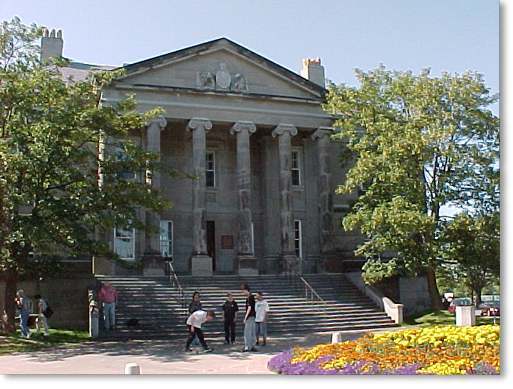1. Prologue - Our Lady's Boobies

The Fallen Madonna with the Big Boobies
and Other Tales of British Newfoundland
an AlternateHistory.com presentation by Dan1988
--
Prologue: Our Lady’s Boobies
https://goo.gl/maps/FZF1ARzpPgv
See those islands on that map? The ones marked with the tack, north of St. John Island, off the coast of western Newfoundland? Yes, those ones. On any map of the area, if those islands are mentioned at all (for example, in Ordnance Survey maps), they will be noted as the Twin Islands. On their own, they’re a beautiful spot – apart from a few buildings used by the few remaining fishermen who try to make a living in an industry while some of the fish species are under a moratorium, the islands are better known to sailors as a navigational waypoint. For the tourist trade, though, they are known by a very different name, with an equally colourful story to tell. It’s easy to understand why.
Before he made his name out in the Pacific Ocean, Captain James Cook had mastered his craft in North America, where he initially started out as a naval officer before moving onto surveying Nova Scotia’s coastlines. During the 1760s, he focused his cartographic expertise on Newfoundland. The Treaty of Utrecht in 1713 had finally placed all of Newfoundland under British control, and in 1699 the English Parliament had passed King William’s Act (officially “An Act to Encourage the Trade to Newfoundland”) – which tried to regulate the fishery trade, yet holds the distinction of being the first piece of legislation specifically aimed at The Rock. With Britain finally getting more or less uncontrolled access to the Gulf of St. Lawrence (save for the French Shore and the islands of St. Pierre and Miquelon, a mere 6 km off the coast of the Island), there arose a need for maps of the Newfoundland coastline, which attracted Captain Cook. His maps, published in 1767, were in use for nearly a century and a half because of their accuracy and attention to detail.
However, there was one mere detail that got changed in those maps. In his journal, Captain Cook referred to those islands as “Our Ladies Bubies”. When the maps were finally published, to the disappointment of the hot-blooded segment of the British population, the name had been changed to their current designation as the “Twin Islands”. When tourism really took off in the 20th century, in response to the curiosity some tourists had with the bizarre and offbeat names that dot the country – as well as the fondness for British humour – that peculiar entry in Captain Cook’s journal was revived. Thus was born the legend of “Our Lady’s Boobies” and the modern fascination of all things Newfoundland in a tourist industry focused on its natural beauty.
-
It has been 519 years since John Cabot’s first voyage out into the North Atlantic to points unknown. This also marks 433 years since Sir Humphrey Gilbert formally claimed The Rock for England and Queen Elizabeth I, 303 years since the Treaty of Utrecht made that claim on Newfoundland official, 192 years since Newfoundland was officially declared a colony (long after most British colonies in North America), and 161 years since Newfoundland attained responsible government. Most importantly, it has been 118 years since Parliament passed the Government of Newfoundland Act, 1898, which made Newfoundland a direct part of the United Kingdom. This longevity of history highlights what some scholars have noticed a striking continuity in Newfoundland between the past and the present. Just outside St. John’s, one of the UK’s most modern and dynamic cities, are many coastal communities, known as outports, where families have eked out a living based on catching fish for centuries. In Labrador and Ungava, beneath the pre-fabricated structures comprising many Northern communities and the hydroelectric projects which have transformed the landscape, are Aboriginal peoples who try to practice the same lifestyle as their ancestors did centuries ago, while also driving around on ATVs or snowmobiles and talking on cellular or satellite phones. The past is also the present here.
We have a general tendency to view Newfoundland and its associated Mainland regions of Labrador and Ungava in isolation; that the forces of exploration and colonization that affected the rest of North America simply did not apply to Newfoundland. Studies of British history also ignore their outer-most region and focus on events in Great Britain and Ireland since they are more “accessible” to the general public. This was not the worldview of many British people back during the Age of Exploration, when peoples of all nationalities came to Newfoundland to fish off its shores, or in the case of Lord Baltimore and the Pilgrims as a temporary sojourn before moving elsewhere – to Maryland and Massachusetts, respectively. The history of Newfoundland is no more or less British than the history of England itself, and is just as colourful. Yet Newfoundland is often times seen as another world, where things have barely changed and its people speak a strange dialect of English. It might as well be either a separate country altogether, or at least a province of Canada.
In reality, Newfoundland did not exist in isolation. True, the colonization process was different from and more difficult than other English and French colonization efforts in North America. True, at times the economic history of the Island almost seems to remain the same for centuries on end. But Newfoundland had long been part of the North American and European worlds, and at times has even been at the centre of those worlds. Through its Aboriginal peoples, living and extinct, Newfoundland also forms part of the great mosaic of diversity that distinguishes the indigenous peoples of the Western Hemisphere, with their variety of languages, cultures, traditions, economies, and shared history of contact with Europeans – for both good and evil. These days, Newfoundland also serves as the UK’s bridge to North America, thanks to Newfoundland becoming the only British colony that directly became part of the UK, and as such it cannot live in isolation.
Part of Newfoundland’s distinctiveness can be traced back to its geography. Rich in natural maritime resources but almost barren in terms of landward resources, the triangular-shaped Island of Newfoundland is the end result of tectonic and glacial forces which stripped the Island bare of most usable resources. Much of the Island, including the Long Range Mountains, are an extension of the great Appalachian Mountains system and thus shares similar characteristics to other mountainous regions, which severely limits the potential of agriculture. Across the Strait of Belle Isle into Labrador and Ungava, both regions are extensions of the Canadian Shield and thus share similar characteristics with most of its large neighbour to the west, south, and north. A great example of the distinctiveness of Newfoundland’s geography is located at Gros Morne National Park, located at a fjord but which is held as a great example of plate tectonics in action.
While its weather is often unpredictable, climatologists and geologists have been able to pinpoint the entirety of the region as either tundra or taiga, sharing similar polar, subarctic, or ocean-influenced humid continental climates. Its weather is shaped by its location where the Labrador Current and Gulf Stream converge, giving the Island its distinctive fog. At the convergence point is the Grand Banks, long one of North America’s richest fishing grounds and currently an area exploited for its oil and natural gas resources, and control over this area has long been a point of contention throughout its history. Small wonder that in Newfoundland’s national anthem, three of its four verses make direct reference to the region’s geography. Also, too, the more unusual customs procedures in Newfoundland compared with the rest of the UK. Whereas British customs procedures are usually straightforward and no different from most of the world, due to its sensitive ecology the Island’s customs procedures are comparatively more invasive and go well beyond what travellers would normally expect, to prevent any invasive species, plants, or soil from making their entrance. Bag inspection, both by machine and by hand, is routine, as is sending any vehicles through a car wash (which, as might be imagined, is well appreciated by travellers).
Despite this limited potential for settlement, humans have been making a living here ever since people crossed the land bridge over the Bering Strait, dependent as they were on the sea for their livelihood. This determination to live in an area that would otherwise have deterred people from potentially living here in the first place has influenced the way of life of most Newfoundlanders, and it is to their endurance that when Europeans crossed the Atlantic, or Aboriginal peoples across the Strait of Belle Isle, they actually survived at all. This can be assumed from the very interesting place names that dot the landscape, including more unusual ones like Come By Chance, Random Island, the Port au Port Peninsula (itself a stronghold for Newfoundland’s French-speaking community), Happy Valley, Eastmain (a Cree settlement in Ungava), and the ever-popular Dildo. If humour is the grease that keeps people going, than certainly Newfoundland needed plenty of it, and it shows.
So, how did Newfoundland become part of the UK in the first place? Harken ye now to a tale of something wonderful from both The Rock and The Big Land …
----
And so begins my quest for a TL project that I’ll finally take to completion. Thanks to Simon and Thande for providing the main impetus for it, to several others (particularly jotabe1789) when I originally conceived it as something entirely different (and, I promise, I’ll eventually get to it!), and also to Brainbin for making sure it all comes out all neat and tidy.
I’m actually very excited by this. No, it does not follow the other trends elsewhere, but is more old-school. On the other hand, I hope you’ll like what will come next. Newfoundland is one of those topics that is outside my comfort zone, and I know that most are not familiar with that speck of land off the coast of mainland Canada with humourous and sometimes very suggestive place names, so I hope that this will help just one bit. As always, constructive criticism is very much well appreciated – and I will definitely need it at times, because I’ll honestly admit there will be areas that I draw a blank on.
All in all, tis’ an interesting journey, and one I'm glad to share with you.
Last edited:

